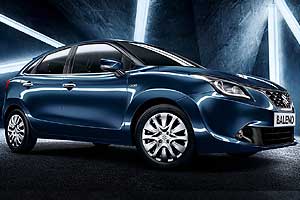Maruti Baleno DDiS 190 Alpha (Price: Rs 8.11 lakh, ex-showroom, Delhi)
Performance
The Maruti Baleno’s 74bhp diesel engine is smaller than the Hyundai Elite i20’s in size and makes 15bhp less. Still, real world performance is quite close, as Maruti has tuned the engine well and used the right gearing. Yes, there is a bit of delay between pressing down on the throttle and a burst of power, but the engine soon picks up speed. Going from 0-100kph takes 13.3 seconds. However, the diesel engine is a bit rough and isn’t as silent as the Hyundai’s.
Ride & handling
The Maruti Baleno has a much nicer balance of ride and handling. The low-speed ride is more absorbent compared to the i20, and though there is a bit of stiffness, the Baleno rides better than Hyundai even as speeds increase. Steering and handling are also nicer. It’s ideally suited to traffic with its faster-acting steering, which is sharp and very precise. And it drives with more confidence and poise in corners too.
Interior
The Maruti Baleno’s dash is finished in what Maruti calls ‘sporty black’. There’s a high-mounted silver central console where the large touchscreen sits, an attractive colour display in the instrument panel and a digital display for the air-con as well; all nice touches. There are, however, plenty of plastic bits borrowed from other Maruti cars like the Swift, and the cabin doesn’t look sporty despite being in black. The central console that dips towards the front is interesting though.
Space & practicality
The Baleno is easily the more spacious of the two cars. The cabin feels wider, the slim seats take up less space and legroom, shoulder room and headroom are very good; as good or even better than that on many sedans. It scores highly on practicality too. It’s easy to get in and out of the car and sitting three abreast at the rear is possible. And the Baleno has plenty of space to store odds, ends and, of course, plenty of cups and bottles.
Equipment
The Baleno comes with some really cool equipment like Apple’s CarPlay, which integrates directly with your iPhone (Android Auto is coming soon), a slick high-resolution touchscreen (Maruti’s Smartplay) and a high-definition colour display in between the dials. Smartplay features USB, Aux, Bluetooth and navigation, but no CD player, but the same applies to the i20’s unit. All but the base versions get twin airbags and ABS. The rear seat splits 60:40 on higher trims.
Elite i20 CRDi Asta (O) (Price: R8.31 lakh, ex-showroom, Delhi)
Performance
The Elite i20 makes a healthier 89bhp, but is the heavier of the two so the power doesn’t go as far. Still, in everyday driving, the i20 is a bit nicer and smoother to drive. It isn’t as responsive as the Baleno’s engine once on the move though. Still, it has the advantage of being a more relaxed cruiser due to the extra sixth gear, and straight-line performance is stronger, with 0-100kph coming up in 12.85sec.
Ride & handling
At low speeds, the i20 thumps through bigger potholes, but as the car picks up speed, the ride improves. It’s also quite nice in and around traffic. The steering is very light so you can change lanes and manoeuvre easily, and straight-line stability is quite impressive too. When it comes to bends, the i20’s steering isn’t accurate, however.
Interiors
The Hyundai has the more upmarket cabin of the two and this is clear from the moment you step inside. The two-tone, beige and brown finish works really well, the design is more mature and grown up, as on a car from a class above, and it has plenty of quality touches, like the metallic highlights that make the cabin feel better crafted and built. Even bits like the gear lever and the steering wheel have a premium feel that you don’t find on the Baleno.
Space & practicality
The Hyundai’s cabin is big and spacious in its own right, but it feels a bit smaller on the inside, and that’s despite the lighter colour. The seats are more substantial and hold you better when the car is on the move. This is true at the rear, where the seat is better contoured than that of the Maruti. There isn’t as much legroom at the back, however, and the seats are a bit softer. But like the Baleno, there’s plenty of stowage for odds, ends and bottles.
Equipment
The plusher i20 has plenty of equipment as well, but slightly trails the Baleno as far as total kit is concerned. It gets a new touchscreen that levels the playing field a bit with the Baleno, and it has rear air-con vents; absent on the Maruti. But otherwise it is the Maruti that is ahead on equipment. Even the boot is smaller at 285 litres. The i20 does get a more robust two-year/unlimited km warranty; the Baleno’s is two years/40,000km.
1st: Maruti Baleno
* For: Ride & handling, space, equipment
* Against: Lacks upmarket feel
* Verdict: A great value-for-money package that’s hard to resist
2nd: Hyundai i20
* For: Cabin quality, refinement
* Against: Not exciting to drive
* Verdict: The more premium of the two, but not as good value
Content Powered by Whatcar?


